written and photographed by Mary L. Peachin
Jan 2002, Vol. 6 No. 3
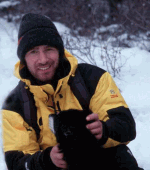 The snow-covered pine and spruce forests of the Canadian Rocky Mountain surrounding the villages of Banff, Lake Louise, and Jasper offer the perfect setting to hop on a horse-driven sleigh, track animal snow prints on the old-fashioned wooden snowshoes, mush behind a team of huskies huddled in a dog sled, or shush or board down steep inclines in back bowls. There are frozen waterfalls for climbing, hiking trails for Nordic skiing, and lakes for skating. Alberta’s Canadian Rockies, comprising Banff and Jasper National Parks, is a winter playground, full of wonder. Its scenic tranquillity and beauty is perfect for those enjoying a variety of cold weather sports.
The snow-covered pine and spruce forests of the Canadian Rocky Mountain surrounding the villages of Banff, Lake Louise, and Jasper offer the perfect setting to hop on a horse-driven sleigh, track animal snow prints on the old-fashioned wooden snowshoes, mush behind a team of huskies huddled in a dog sled, or shush or board down steep inclines in back bowls. There are frozen waterfalls for climbing, hiking trails for Nordic skiing, and lakes for skating. Alberta’s Canadian Rockies, comprising Banff and Jasper National Parks, is a winter playground, full of wonder. Its scenic tranquillity and beauty is perfect for those enjoying a variety of cold weather sports.
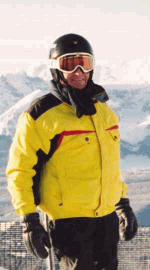 Double black Delirium Dive, located on the North Face of Lookout Mountain in Banff’s Sunshine Village, has reopened after 18 years of closure by Canadian Parks Service (due to the danger in controlling avalanche and providing rescue services). The extreme terrain offers expert skiers and snowboarders a vertical relief of 2300 feet with a 39-degree incline. Strict rules are enforced: thrill seekers must wear avalanche transceivers and carry a rescue shovel.
Double black Delirium Dive, located on the North Face of Lookout Mountain in Banff’s Sunshine Village, has reopened after 18 years of closure by Canadian Parks Service (due to the danger in controlling avalanche and providing rescue services). The extreme terrain offers expert skiers and snowboarders a vertical relief of 2300 feet with a 39-degree incline. Strict rules are enforced: thrill seekers must wear avalanche transceivers and carry a rescue shovel.
Sunshine Village, which embraces the Continental Divide, has a location where the weather patterns cause clouds to dump as much as 33 feet snowfall annually. There is no such thing as artificial snow at Sunshine. 92 ski runs (for all levels of ability) cover almost 3200 acres; a high-speed passenger gondola accesses its 3500 vertical feet.
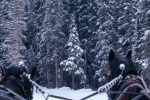 Lake Louise Ski Area offers 100 runs spanning four mountain faces and 4000 skiable acres. There are stunning views of Louise and Moraine lakes. This ski area also caters to the expert skier with the steep pitches of The Diamond Mine and The Jewelry Box runs in the back bowls area of Ptarmigan/Paradise trails.
Lake Louise Ski Area offers 100 runs spanning four mountain faces and 4000 skiable acres. There are stunning views of Louise and Moraine lakes. This ski area also caters to the expert skier with the steep pitches of The Diamond Mine and The Jewelry Box runs in the back bowls area of Ptarmigan/Paradise trails.
Marmot Basin, 12 miles south of Jasper, boasts of immaculately groomed trails and deep powder filled bowls in a pristine setting. 20 new runs on the mountain faces of Chalet Slope and Eagle East are now accessible by a new quad chair lift. Marmot’s runs are divided almost equally for all levels of experience.
 While skiing may attract the majority of visitors to Alberta’s Canadian Rockies, there is a wide choice of other winter activities. At Fairmont’s Chateau Lake Louise, wooden snowshoes (instead of the newer, smaller lightweight aluminum models) are used in keeping with past tradition. Our guide, who spent her summer tracking animals for the Canada Parks Service, shared some of her expertise during our snow shoe outing. She taught us how to measure the size of the animal by its print and determine its direction of travel. The half dozen of us on this mile hike were able to identify prints of the rarely seen wolverine and moose, snowshoe hares, and a coyote. We returned to the staging area called “the barn” near the Chateau in time to catch a sleigh ride down to partially frozen glacial Lake Louise. Two large Percheon horses, relatives of the Clydesdale, pulled the sleigh as a group of us huddled under blankets.
While skiing may attract the majority of visitors to Alberta’s Canadian Rockies, there is a wide choice of other winter activities. At Fairmont’s Chateau Lake Louise, wooden snowshoes (instead of the newer, smaller lightweight aluminum models) are used in keeping with past tradition. Our guide, who spent her summer tracking animals for the Canada Parks Service, shared some of her expertise during our snow shoe outing. She taught us how to measure the size of the animal by its print and determine its direction of travel. The half dozen of us on this mile hike were able to identify prints of the rarely seen wolverine and moose, snowshoe hares, and a coyote. We returned to the staging area called “the barn” near the Chateau in time to catch a sleigh ride down to partially frozen glacial Lake Louise. Two large Percheon horses, relatives of the Clydesdale, pulled the sleigh as a group of us huddled under blankets.
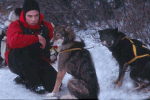 Near Kananaskis Spray Lakes, about 40-minutes south of Banff, Snowy Owl Sled Dog tours offer a variety of tours. Owner Connie Arsenault briefed us on her philosophy of being humble to the elements. “Winter conditions in this area can be harsh and it’s wise to always be prepared. “If you are not the lead dog, the scenery never changes.” Connie rotates her teams that include 137 dogs and a staff of 24. Clients can ride the two-person sleds or have the option of driving the sled by riding one of the sled skis with a guide.
Near Kananaskis Spray Lakes, about 40-minutes south of Banff, Snowy Owl Sled Dog tours offer a variety of tours. Owner Connie Arsenault briefed us on her philosophy of being humble to the elements. “Winter conditions in this area can be harsh and it’s wise to always be prepared. “If you are not the lead dog, the scenery never changes.” Connie rotates her teams that include 137 dogs and a staff of 24. Clients can ride the two-person sleds or have the option of driving the sled by riding one of the sled skis with a guide.
“Hike” is used to start the dogs mushing and “whoa” means stop. “Gee” is the command to turn right, “haw ” to the left. Mary-Ann Bendel and I snuggled into a sled lead by musher Bill, who enthusiastically commanded “his lovelies,” an eight dog team led by Doc and Hilary to “hike.” We hunkered down against the wind totally amazed at the responsiveness and unique characteristics of each dog runny snowy trails at approximately10 mph.
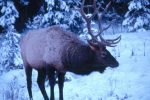 In Jasper, Brenda Currie, owner of Beyond the Beaten Path, leads winter wild life tours. Animals are easier to sight in the snow because their tracks are more obvious. Rocky Mountain elk (Wapiti or white butt) nibbled grass along the road. Rocky Mountain Bighorn sheep licked salt placed by road maintenance along the highway. Rams, who rut (a part of the mating ritual to declare dominance) later in the fall than elk, were still locking horns with other rams before romancing the ewes.
In Jasper, Brenda Currie, owner of Beyond the Beaten Path, leads winter wild life tours. Animals are easier to sight in the snow because their tracks are more obvious. Rocky Mountain elk (Wapiti or white butt) nibbled grass along the road. Rocky Mountain Bighorn sheep licked salt placed by road maintenance along the highway. Rams, who rut (a part of the mating ritual to declare dominance) later in the fall than elk, were still locking horns with other rams before romancing the ewes.
We didn’t see any of the 130 grizzly bears living in Jasper valley because they were in hibernation. Cliffs edged by the ragged limestone peaks of the Colin range came into view as we turned a corner in Maligne Canyon. We followed the shoreline of Lake Medicine as mist rose from areas of the lake not yet frozen. Heading back to Jasper Lake Lodge, the pink-colored quartzite of 10,000-foot Pyramid Mountain gleamed in the morning sun. While our search for wolves and woodland caribou had not been successfully, we were pleased to have some close up views of the elk and sheep.
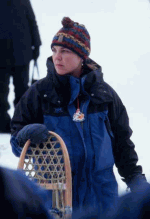 Wintertime travel between Banff and Jasper (about 200 miles of separation) is an adventure. Driving the less beaten path called the Bow Valley Parkway between Banff and Lake Louise herds of elk, bighorn sheep and whitetail deer sometimes blocked the two-lane road. Between the two villages, Trans Canada Highway #1 is protected from straying animals by game fences. Guide Wendy Bush regaled us with stories about the wildlife ignoring our vehicle; animals totally habituated to traffic and the encroachment of humanity in Banff National Park.
Wintertime travel between Banff and Jasper (about 200 miles of separation) is an adventure. Driving the less beaten path called the Bow Valley Parkway between Banff and Lake Louise herds of elk, bighorn sheep and whitetail deer sometimes blocked the two-lane road. Between the two villages, Trans Canada Highway #1 is protected from straying animals by game fences. Guide Wendy Bush regaled us with stories about the wildlife ignoring our vehicle; animals totally habituated to traffic and the encroachment of humanity in Banff National Park.
“The bull elk standing there has no fear of us. It’s not his rack of antlers that attracts the cow; it’s the volume of his “rut” or bugling call. Females like to mate with a bull that has a good set of lungs presuming their calves will inherit the “wind power” making them more capable of eluding predators.”
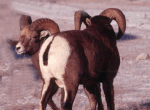 Wendy told us that the building of the Trans Canada highway between Banff and Jasper destroyed a natural corridor for the park’s wildlife. Underpasses were built to provide access for the animals to cross the highway. The elk were able to adapt, but wolves were terrified of overhead traffic noise in the tunnels. It didn’t take long for the wolves to learn that penning bighorn sheep against the Trans Canada fence made for an easy meal. The park service then built overpasses as an alternative route for the animals. Instead of using this “above the road” corridor, elk began to migrate into the village of Banff. Town residents found elk occasionally confusing them with male elk (wanting to butt them) during the rutting season, and females giving birth on “Mrs. Smith’s lawn.” Packs of wolves soon learned that elk in the city were easy prey. It didn’t take long for the town folks to realize the danger inherent in sharing their village with wildlife and pay proper respect to the animals.
Wendy told us that the building of the Trans Canada highway between Banff and Jasper destroyed a natural corridor for the park’s wildlife. Underpasses were built to provide access for the animals to cross the highway. The elk were able to adapt, but wolves were terrified of overhead traffic noise in the tunnels. It didn’t take long for the wolves to learn that penning bighorn sheep against the Trans Canada fence made for an easy meal. The park service then built overpasses as an alternative route for the animals. Instead of using this “above the road” corridor, elk began to migrate into the village of Banff. Town residents found elk occasionally confusing them with male elk (wanting to butt them) during the rutting season, and females giving birth on “Mrs. Smith’s lawn.” Packs of wolves soon learned that elk in the city were easy prey. It didn’t take long for the town folks to realize the danger inherent in sharing their village with wildlife and pay proper respect to the animals.
 As we passed the sheer cliffs of Castle Rock, Wendy told the story when Canada named the mountain in honor of United States President Eisenhower. When the President was unable to pry himself from the world class golf course at the Fairmont Banff Springs Hotel, a resort known as the “Castle in the Rockies,” the Canadians had second thoughts about naming this great mountain in honor of another country’s president. “There is a lush area behind that far buttress of Castle Rock that we call the Eisenhower green.”
As we passed the sheer cliffs of Castle Rock, Wendy told the story when Canada named the mountain in honor of United States President Eisenhower. When the President was unable to pry himself from the world class golf course at the Fairmont Banff Springs Hotel, a resort known as the “Castle in the Rockies,” the Canadians had second thoughts about naming this great mountain in honor of another country’s president. “There is a lush area behind that far buttress of Castle Rock that we call the Eisenhower green.”
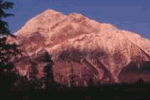 Heading northward to Jasper National Park, we traveled along the snow-covered Icefield Parkway. Originally a small trail used by fur traders, the road is now a two-lane highway between Lake Louise and Jasper. During the 200-mile trip we saw less than a dozen cars going in either direction. Wildlife sightings included a lone coyote crossing the road, and a bighorn ram standing at the road’s edge not far from a herd of elk.
Heading northward to Jasper National Park, we traveled along the snow-covered Icefield Parkway. Originally a small trail used by fur traders, the road is now a two-lane highway between Lake Louise and Jasper. During the 200-mile trip we saw less than a dozen cars going in either direction. Wildlife sightings included a lone coyote crossing the road, and a bighorn ram standing at the road’s edge not far from a herd of elk.
Near Peyto Lake we entered the upper regions of the subalpine zone where trees appeared stunted, a condition caused by exposure to extreme weather and a short growing season. We crossed the frozen Saskatchewan River, an important passageway for early fur traders, then approach the limestone cliffs of Cirrus mountain. Small waterfalls seeping from its face are known as The Weeping Wall, a destination for ice climbers challenged by the sheer turquoise ice.
The 1400-foot Sunwapta Pass marks the boundary between Banff and Jasper National Parks. Entering the largest mountain park in Canada, we approach the Columbia Icefields, 125 square miles of ice oozing 200 glaciers. Remnants of the Earth’s last ice age, the meltwater flows into the Arctic, Atlantic, and Pacific oceans.
In 1907, the town of Jasper was named for its discoverer, fur trader Jasper Hawes. Less than ten years later, the Brewster brothers built what they called “tent city.” The Canadian National Railway bought out the Brewsters in 1924, then sold the property to Canadian Pacific Hotels and Resorts in 1988. Jasper National Park encompasses 4000 square miles (with only one traffic light) and the “Tent City” has evolved into the luxurious 1000-acre Fairmont Jasper Park Lodge. Fairmont’s Jasper Lake Lodge, wedged between Lac Beauvert and Lake Mildred under the conical snowy peak of Pyramid Mountain, may be best known for its championship Par 71 Stanley Tompson golf course, recently restored to its 1924 design. But in winter months, visitors come to skate and play ice hockey on these lakes, ice climb frozen waterfalls, or ski at Marmot Basin. Others hike the trail following icy waterfalls and caves in Maligne Canyon.
Alberta’s Canadian Rockies offers a tranquil scenic beauty in winter that excludes the frenetic pace of the summer tourist season. This is the place for those looking for excellent facilities, luxurious accommodations, excellent tour companies, and diversity in their choices of winter sports.
If you go:
Calgary is the gateway city to the Canadian Rockies. Rental cars and shuttles are available for the hour and a half trip.
Fairmont Hotels & Resorts:
Banff, Chateau Lake Louise, and Jasper Park Lodge (800-441-1414) or go to www.fairmont.com Banff’s Sunshine Village (877-542-2633) or go to www.skibanff.com Lake Louise (403-522-3555) or e-mail [email protected] or go to www.skilouise.com Jasper’s Marmot Basin (800-473-8135) or e-mail [email protected] or check out www.skimarmot.com Snowy Owl Sled Dog Tours (888-311-MUSH) or e-mail [email protected] or go to www.snowyowltours.com Beyond the Beaten Path winter adventures and sightseeing tours (780) 852-5650 [email protected] or go to www.jasperbeyondthebeatenpath.com
